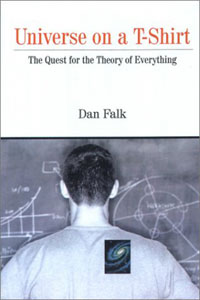|
|
Review: Universe on a T-shirt
by Jeff Foust
Monday, August 23, 2004
Universe on a T-Shirt: The Quest for the Theory of Everything
By Dan Falk
Arcade Publishing, 2004
Hardcover, 256 pp., illus.
ISBN 1-55970-707-0
US$24.95
Next year marks the centennial of Albert Einstein’s annus mirabilis: that amazing year when the obscure Swiss patent clerk vaulted to fame in the physics world with a series of papers on the photoelectric effect, Brownian motion, and, most famously, special relativity. The centennial is already attracting considerable attention—Discover magazine recently devoted an entire issue solely to Einstein—and that focus on Einstein and his accomplishments will likely grow over the next year. That attention should also shed light on one of Einstein’s later failures: an unsuccessful bid to unite the various disparate forces of the universe into a single all-encompassing “Theory of Everything”. Einstein died before he could accomplish that, and efforts before and since have also failed to provide a single, elegant theory, as Dan Falk recounts in Universe on a T-Shirt.
The whimsical title of Falk’s book stems from the a desire by contemporary physicists to come up with a model of the universe so simple and elegant that it could be summarized on a t-shirt, as E=mc2, F=ma, and Maxwell’s equations of electromagnetism have been (as a trip to the apparel section of the campus bookstore of nearly any university with a physics department will reveal.) Falk, though, starts long before the t-shirt existed, beginning his survey with the ancient Greeks and following the progress—and the missteps—that have occurred through the modern day, from the origins of the concept of atoms to the latest in string theory.
| The continued pursuit for a Theory of Everything will doubtless continue to shape space science and astronomy spacecraft missions for decades to come. |
A book as short as Universe on a T-Shirt—less than 250 pages when taking endnotes and the index into account—suggests that it will be short on technical details, and that is the case here. Instead, Falk has focused on the people who made the critical advances over the centuries. These are people familiar to anyone with a passing familiarity with physics: Kepler, Galileo, Newton, Maxwell, Planck, and, of course, Einstein, among many others. The book is written at a level that the interested layman can understand, although by the end of the book, with a discussion of topics like p-branes and M-theory, will likely leave some readers wanting more information, and others just befuddled. That is not necessarily a limitation of the author but instead reflects the increasing mathematical nature of physics, a topic Falk touches upon late in the book.
The topic of a Theory of Everything might seem a little disconnected from space. However, observations of the universe from the ground and, more recently, by spacecraft, have generated evidence that have shaped efforts to craft such a theory. Earlier this year, NASA launched the Gravity Probe B spacecraft on a mission to experimentally verify Einstein’s model of general relativity. The continued pursuit for a Theory of Everything will doubtless continue to shape space science and astronomy, and the spacecraft missions associated with them, for decades to come. For those looking for an introduction—or refresher—on this search for the ultimate physics theory, Universe on a T-Shirt is a good place to start.
Jeff Foust (jeff@thespacereview.com) is the editor and publisher of The Space Review. He also operates the Spacetoday.net web site and the Space Politics weblog.
|
|
